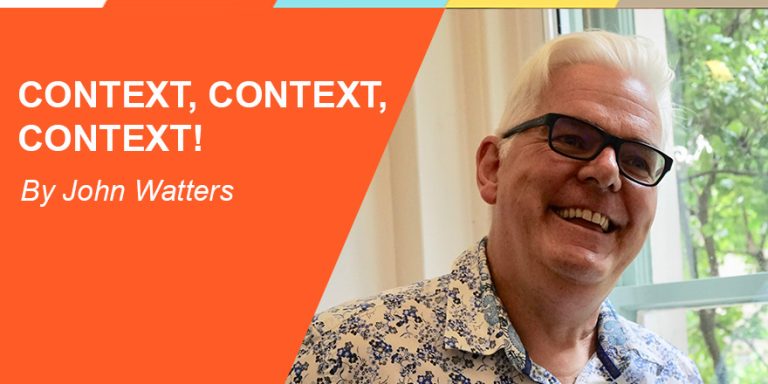Are we doing the work that is needed or the work that is comfortable?
“Taking a new step or uttering a new word is what people fear most.” Dostoyevsky
I notice how quite frequently we talk on the one hand of the need for innovation, transformation, world-class practice or other words to describe great aspirations, and at the same time, we keep the work and ourselves in the comfort zone. This misalignment matters. We dilute our integrity. We are not doing the work that is needed.
So that’s simple then. Speak with integrity: marry your actions with your words. If only it was so simple!
Firstly, we need to distinguish between two categories of work: technical challenges and adaptive challenges. Technical challenges are where the problem definition is clear, where stakeholders are aligned and the solution is known. Complex or adaptive challenges are where the problem definition is contested and ambiguous, stakeholders may differ on where they think we need to get to, and how to get there. My work is helping clients with their adaptive challenges.
How do you discover and agree the work that needs to be done amidst complex challenges? The first step, where we frequently miss the opportunity for real partnership, is contracting: the discussion between the ‘customer’ and the ‘performer’ (the person undertaking the work which could be an external consultant, a team member, a colleague from an internal function) about the work that needs to be done.
The performer makes one of two common moves, both of which may fail to add value in the context of a complex challenge:
-
- Accede to the request as it is framed: the ‘servant’ or ‘one-down’ power position. The problem is where you make this response reflexively, especially when you have reservations about what is being proposed. If I’m present and observe this disquiet on the part of the performer I ask (usually off-line) why they are silent on what they see needs to happen. Typical responses include: the relationship isn’t strong enough to raise the issue; they won’t listen or be receptive; I don’t feel empowered or safe to make that point – the risk are too high; the resulting disagreement wouldn’t be productive and could undermine the relationship.
- Hold the line – a response based on what I think is needed from my position or function: typically an ‘expert’ or ‘one-up’ power position. . The limitation of this response, when done reflexively, is its failure to listen closely enough and take into account important aspects of the local context. For an external consultant in a conversation with the customer this might be their standard way of responding to this category of situation. Internal functions (such as HR, Finance, IT etc.) working with the business may respond with a standardised response or procedure appropriate to what they perceive as this category of situation. The functional response, fits with the functional line and policy, and may create corporate consistency but may not be adding value to this particular situation. The systemic tension is between differentiation (local adaptation) or homogenisation (commonality, consistency): ‘holding the line’ simplifies this tension by emphasising consistency and standardisation.
Both ‘moves’ share common characteristics:
-
-
- Partnership is in name only, the insight and expertise lies with one party.
- Conversations are often characterised by certainty ( I know what is needed or they know what is needed) rather than curiosity ( What do I/we think is needed? What am I not seeing that the other party is seeing?).
- Power dynamics play out, usually unawarely, and one or more viewpoints are marginalised and an unproductive battle of messages ensues with little listening to the validity and potential contribution of each perspective.
- They diminish value creation when they are done reflexively.
-
The third move, which is too infrequently used, and which is the most powerful, is:
- Partnering – the partner mindset where both parties are jointly committed to the success of whatever process, project or endeavour they are engaged in and bring their experience, expertise and insight into creating the best way forward. When you observe a partnering conversation the quality of conversation – both talking and listening – is quite different and includes an alternation between:
- Framing the purpose of the conversation, naming the dilemma or challenge that is to be resolved, being explicit about what assumptions you think are shared and which are not, putting your perspective and that of the others on the table for examination and inquiry.
- Advocating options, perceptions, feelings and strategies for actions. Advocacy of thinking is often well-understood; but the ability to sense our feelings, including what we feel is happening at this current moment in the context of a messy situation, judging how and when to express our feelings, is very difficult and a key skill to be developed in partnering.
- Illustrating fleshes out the advocacy, gives it some colour and some specificity. We make clear the data we are referring to, the examples which illustrate our advocacy, the interpretations we are making and the conclusion we are drawing.
- Inquiring, into how the other party frames, advocates and illustrates the issues at hand. Where there is disagreement we encourage the other party to inquire into our view and to test our assumptions. The mindset of partnering is that we are willing to disconfirm our own conclusions and assumptions if they are not valid or applicable to this situation: this is genuine inquiry as opposed to inquiry as a rhetorical device.
The partnering move creates a way forward which takes account of the needs of both parties. The power dynamic in partnering is different from the one-down and one-up positions of ‘servant’ and ‘expert’; both examples of unilateral power. Partnering assumes a competence with employing different aspects of power (positional , expert, psychological…) as needed but in subordination to a relational power based on a principle of mutuality and a starting point of positive regard for the other. The latter is not sentimental but rather a recognition that I do not have the monopoly of insight and that partnership is a renewable resource which I can deplete or renew by my actions.
The development of mastery in partnership conversations takes time, I am skimming the surface of the territory here. Creating a bullet point list suggests it’s primarily a questions of skills and knowledge. More important is the intention and integrity with how we engage those skills: our way of being.
As for being comfortable, it’s not all it’s cracked up to be.
- The insistence on comfort, “are we all comfortable with this?”, limits the possibility of something new emerging.
- Anxiety, the opposite of comfort, is undervalued. TS Elliot observed, “anxiety is the handmaiden of creativity.”
- Learning and anxiety are travelling companions: they go together. Learn to befriend, even welcome, your anxiety. Hello, my old friend, back again for more learning!
- Remember leadership and learning are twinned. At its heart leadership is bringing something new into the world that wasn’t present before. Birth, including birthing new ideas and ways of working, is anything but comfortable but it is also life-giving.
- For those of us uncomfortable with this constant tango of emergent change and continuity we have the words of the poet Rumi to comfort us:
“As you start to walk on the way, the way appears.”
Forthcoming Workshops (click on each link for more information)
Systemic Lens – Leading Beyond Boundaries, 8 May 2013, London
Cultural Lens – Leading Successful Integration, 7 May 2013, London
Personal and Interpersonal Lens – Change the Conversation, Change the Organisation, Autumn 2013 (date tbc)
Exploring whole systems change
Here be dragons: Leading in complex times – John Watters
What do you think they think of you? The stories that derail us – Chris Yates
Are we doing the work that is needed or the work that is comfortable? – John Watters
You can find more of our posts on our blog and can keep up to date with any future editions through our newsletter, here.
==



